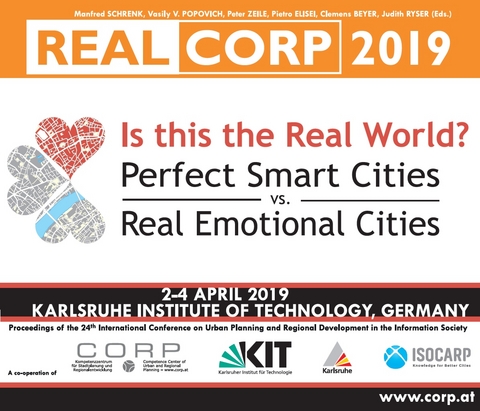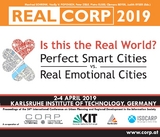IS THIS THE REAL WORLD? Perfect Smart Cities vs. Real Emotional Cities
Proceedings of the 24th International Conference on Urban Planning, Regional Development and Information Society
Seiten
2019
CORP - COnsulting Research Projects (Hersteller)
978-3-9504173-6-4 (ISBN)
CORP - COnsulting Research Projects (Hersteller)
978-3-9504173-6-4 (ISBN)
- Titel nicht im Sortiment
- Artikel merken
Cities have been created by mankind for thousands of years now, as places for people to live and where they can best develop their talents and activities in work-sharing societies.Although there is still a huge demand for physical structures, lately lots of the discussion on the future of cities has been focusing on bringing digital technologies into cities. The term “Smart Cities” has been excessively used and bears the hope and promise that cities will become more efficient but also more livable.“Smart Cities Solutions” has also become a major industry with a huge future potential.
Cities do not just consist of bricks, mortar, steel, glass and – recently – ICT. A city has an identity, a “spirit”, it is emotional, and this is often something very important for a city and its places and districts, and of course for its citizens. Cities are “home”, there can be feel-good places as well as areas rather to avoid, depending on many factors: common and individual ones. What makes the “spirit of a city” or a place?
Whereas renderings in the Smart City context all too often show almost perfect cities, real cities have their shiny places, but most probably also their “dark sides”. What is the situation and the future of “THE REAL WORLD”? What is the relation between longing for “Perfect Smart Cities” and “Real Emotional Cities”? Will cities and neighbourhoods be “standardized” and more look and feel like each other or will they keep their identities? Will this be just decided in market values?
Can urban planning support keeping and creating places, spaces and cities – “Real Emotional Cities”? What are the tools for the 21st century city? Of course we must not forget that sustainability and resilience stay primary goals for urban development.
REAL CORP 2019 explored the relations and differences between standardisation trough technical innovation on the one hand and the quest for uniqueness and peculiarity on the other hand. Seit tausenden von Jahren baut die Menschheit Städte – nicht nur als Lebensraum, sondern auch um ihre Fertigkeiten und Aktivitäten im Rahmen einer arbeitsteiligen Gesellschaft voranzutreiben. Obwohl es weiterhin einen großen Bedarf an physischen Strukturen gibt, konzentriert sich ein Großteil der Diskussion um die Zukunft unserer Städte auf digitale Technologie. Der Begriff „Smart City“ wird intensiv genutzt und birgt sowohl Hoffnung als auch Versprechen, dass Städte effizienter und lebenswerter werden. Unter dem Begriff „Smart City Solutions“ ist mittlerweile eine große Industrie mit hohem Potenzial entstanden.
Städte bestehen nicht nur aus Ziegeln, Mörtel, Stahl, Glas und – seit einiger Zeit – IKT. Eine Stadt hat eine Identität, eine „Seele“, sie ist emotional – und das ist oft etwas sehr Wichtiges für eine Stadt, ihre Räume und ihre Viertel und natürlich auch für ihre Einwohner. Städte sind ein Zuhause, es gibt Wohlfühlorte genau so wie Gegenden, die man eher vermeidet – abhängig von vielen gemeinsamen und individuellen Faktoren. Was macht den Geist, die Seele einer Stadt oder eines Orts aus?
Während Smart-City-Renderings nur allzu oft perfekte, makellose Städte zeigen, haben echte Städte ihre schönen, aber auch ihre dunklen Seiten? Wie sieht die Situation und die Zukunft der „REALEN WELT“ aus? Wie ist das Verhältnis zwischen dem Streben nach „perfekten smarten Städten“ und „echten emotionalen Städten“? Werden Städte und ihr Umland standardisiert und vereinheitlicht werden oder können sie ihre Identität behalten? Und entscheidet sich das nur über Marktwerte?
Kann Raumplanung das Bewahren und Schaffen von Plätzen, Räumen und Städten – also „echten emotionalen Städten“ – unterstützen? Was sind die Werkzeuge für die Stadt des 21. Jahrhunderts? Dabei darf selbstverständlich nicht außer Acht gelassen werden, dass Nachhaltigkeit und Resilienz weiterhin primäre Ziele für die Stadtentwicklung sind.
Die REAL CORP 2019 beschäftigte sich mit den Verbindungen und Unterschieden zwischen Standardisierung durch technische Innovation einerseits und dem Streben nach Einzigartigkeit und Individualität andererseits.
Cities do not just consist of bricks, mortar, steel, glass and – recently – ICT. A city has an identity, a “spirit”, it is emotional, and this is often something very important for a city and its places and districts, and of course for its citizens. Cities are “home”, there can be feel-good places as well as areas rather to avoid, depending on many factors: common and individual ones. What makes the “spirit of a city” or a place?
Whereas renderings in the Smart City context all too often show almost perfect cities, real cities have their shiny places, but most probably also their “dark sides”. What is the situation and the future of “THE REAL WORLD”? What is the relation between longing for “Perfect Smart Cities” and “Real Emotional Cities”? Will cities and neighbourhoods be “standardized” and more look and feel like each other or will they keep their identities? Will this be just decided in market values?
Can urban planning support keeping and creating places, spaces and cities – “Real Emotional Cities”? What are the tools for the 21st century city? Of course we must not forget that sustainability and resilience stay primary goals for urban development.
REAL CORP 2019 explored the relations and differences between standardisation trough technical innovation on the one hand and the quest for uniqueness and peculiarity on the other hand. Seit tausenden von Jahren baut die Menschheit Städte – nicht nur als Lebensraum, sondern auch um ihre Fertigkeiten und Aktivitäten im Rahmen einer arbeitsteiligen Gesellschaft voranzutreiben. Obwohl es weiterhin einen großen Bedarf an physischen Strukturen gibt, konzentriert sich ein Großteil der Diskussion um die Zukunft unserer Städte auf digitale Technologie. Der Begriff „Smart City“ wird intensiv genutzt und birgt sowohl Hoffnung als auch Versprechen, dass Städte effizienter und lebenswerter werden. Unter dem Begriff „Smart City Solutions“ ist mittlerweile eine große Industrie mit hohem Potenzial entstanden.
Städte bestehen nicht nur aus Ziegeln, Mörtel, Stahl, Glas und – seit einiger Zeit – IKT. Eine Stadt hat eine Identität, eine „Seele“, sie ist emotional – und das ist oft etwas sehr Wichtiges für eine Stadt, ihre Räume und ihre Viertel und natürlich auch für ihre Einwohner. Städte sind ein Zuhause, es gibt Wohlfühlorte genau so wie Gegenden, die man eher vermeidet – abhängig von vielen gemeinsamen und individuellen Faktoren. Was macht den Geist, die Seele einer Stadt oder eines Orts aus?
Während Smart-City-Renderings nur allzu oft perfekte, makellose Städte zeigen, haben echte Städte ihre schönen, aber auch ihre dunklen Seiten? Wie sieht die Situation und die Zukunft der „REALEN WELT“ aus? Wie ist das Verhältnis zwischen dem Streben nach „perfekten smarten Städten“ und „echten emotionalen Städten“? Werden Städte und ihr Umland standardisiert und vereinheitlicht werden oder können sie ihre Identität behalten? Und entscheidet sich das nur über Marktwerte?
Kann Raumplanung das Bewahren und Schaffen von Plätzen, Räumen und Städten – also „echten emotionalen Städten“ – unterstützen? Was sind die Werkzeuge für die Stadt des 21. Jahrhunderts? Dabei darf selbstverständlich nicht außer Acht gelassen werden, dass Nachhaltigkeit und Resilienz weiterhin primäre Ziele für die Stadtentwicklung sind.
Die REAL CORP 2019 beschäftigte sich mit den Verbindungen und Unterschieden zwischen Standardisierung durch technische Innovation einerseits und dem Streben nach Einzigartigkeit und Individualität andererseits.
| Erscheint lt. Verlag | 4.4.2019 |
|---|---|
| Verlagsort | Wien |
| Sprache | englisch; deutsch |
| Maße | 142 x 124 mm |
| Gewicht | 101 g |
| Themenwelt | Naturwissenschaften ► Geowissenschaften ► Geografie / Kartografie |
| Schlagworte | Nachhaltigkeit • Smart City • Stadtplanung • sustainability • urban planning |
| ISBN-10 | 3-9504173-6-2 / 3950417362 |
| ISBN-13 | 978-3-9504173-6-4 / 9783950417364 |
| Zustand | Neuware |
| Haben Sie eine Frage zum Produkt? |

